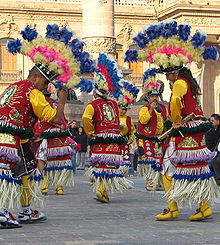- Matachines
-
"Matachin" redirects here. For the Bellowhead album, see Matachin (album). For the gay rights group, see Mattachine Society.
Matachines (Spanish matachín, or religious dancer) are bands of Mexican mummers who wander from village to village or from house to house dancing and hosting several Roman Catholic celebrations. They are found in northern Mexico especially in La Laguna Region (Coahuila and Durango), Sinaloa, Monterrey, and Chihuahua. They are also very popular in Northern New Mexico and around the Rio Grande, specifically in the border cities of El Paso, Texas, Juarez, Chihuahua (Mexico) and Las Cruces, New Mexico.
Even though they dance and host celebrations throughout the year, their most important performing season is Advent (mostly because the day of Our Lady of Guadalupe falls in that season on December 12 and she is celebrated starting in December and ending about one week before Christmas Eve). The dancers are known for playing in rough-and-ready style a set drama based on the history of Montezuma.[disambiguation needed
 ] Even though the dances are based on this story, people who join the Matachines do it for a deeper religious purpose, since most of them join to venerate either Mother Mary (Our Lady of Guadalupe, Our Lady of Lourdes, Immaculate conception, etc.), a saint (the group usually chooses the saint that pertains to the church they belong to), or simply to worship Christ or God the Holy Trinity.
] Even though the dances are based on this story, people who join the Matachines do it for a deeper religious purpose, since most of them join to venerate either Mother Mary (Our Lady of Guadalupe, Our Lady of Lourdes, Immaculate conception, etc.), a saint (the group usually chooses the saint that pertains to the church they belong to), or simply to worship Christ or God the Holy Trinity.Dressed in fantastic Indian costumes, the chief characters are El Monarca the monarch (Montezuma), the captains (usually consist of 2-4 and are Montezuma's main generals), La Malinche, or Malintzin, the Indian mistress of Hernán Cortés; El Toro, the bull, the malevolent comic man of the play (also symbolizes Satan), dressed in buffalo skin with the animal's horns on his head (which can also be dressed differently but always as a bad character, wearing monstrous masks with ragged clothing); Abuelo, the grandfather, and Abuela, grandmother. With the help of a chorus of dancers they portray the desertion of his people by Montezuma, the luring of him back by the wiles and smiles of La Malinche, the final reunion of king and people and the killing of El Toro, who is supposed to have made all the mischief. Much symbolism is seen in these groups. The most basic symbol of the dance is good vs. evil, with good prevailing. Montezuma and la Malinche represent good, and the bull who represents mischief, Hernán Cortés, represents Satan or evil.
The Indian costumes, the rattles, the arch and the bow are all blessed by a priest, and as he blesses the equipment of that group, it signifies that the priest has agreed to adopt the specific dancing group for that specific church. The dances performed by the matachines, though, have significant symbolism; for example, the dances are prayers and through these prayers and symbolism, they are able to host celebrations, such as rosaries, and or a celebration venerating and or honoring Mary, a saint, or worshiping God (note: the celebrations usually only honor or venerate The Virgin Mary, Our Lady of Guadalupe ("La Virgen de Guadalupe", which translates literally as "The Virgin of Guadalupe").
Reference
 This article incorporates text from a publication now in the public domain: Chisholm, Hugh, ed (1911). Encyclopædia Britannica (11th ed.). Cambridge University Press.
This article incorporates text from a publication now in the public domain: Chisholm, Hugh, ed (1911). Encyclopædia Britannica (11th ed.). Cambridge University Press.External links
Categories:- Mexican culture
- New Mexico culture
Wikimedia Foundation. 2010.

